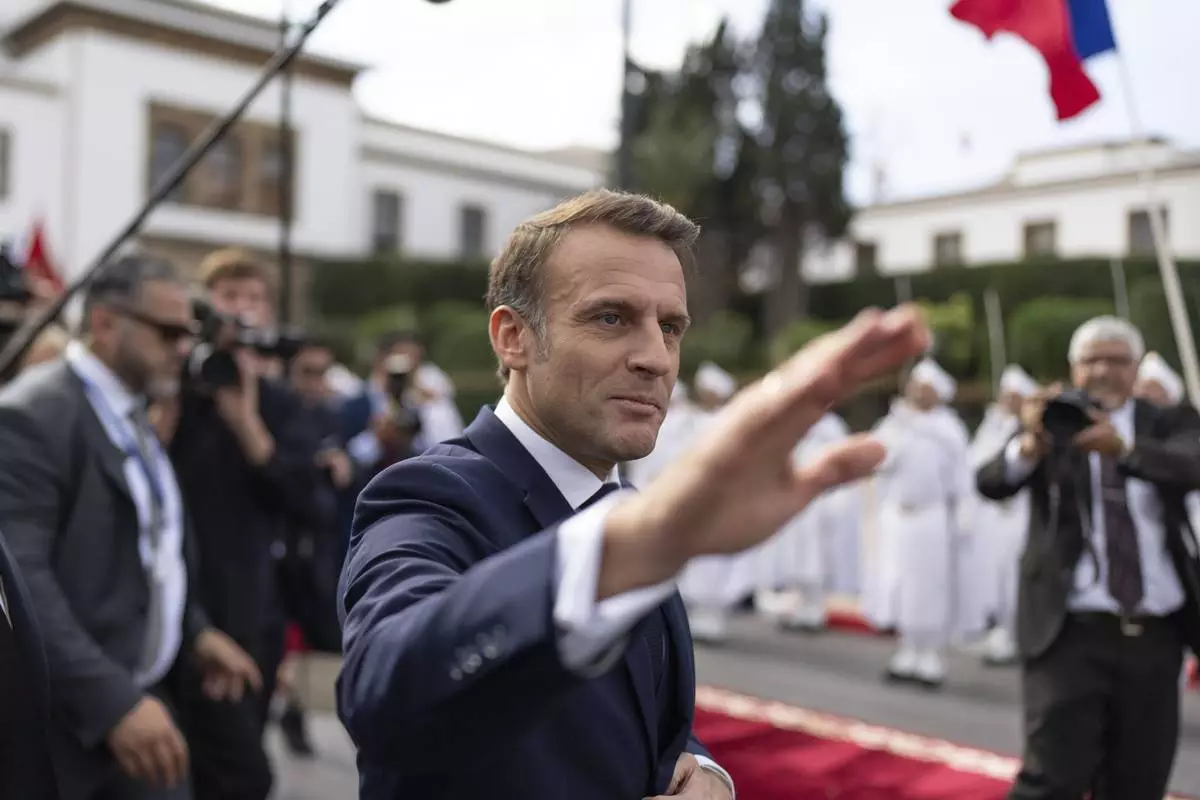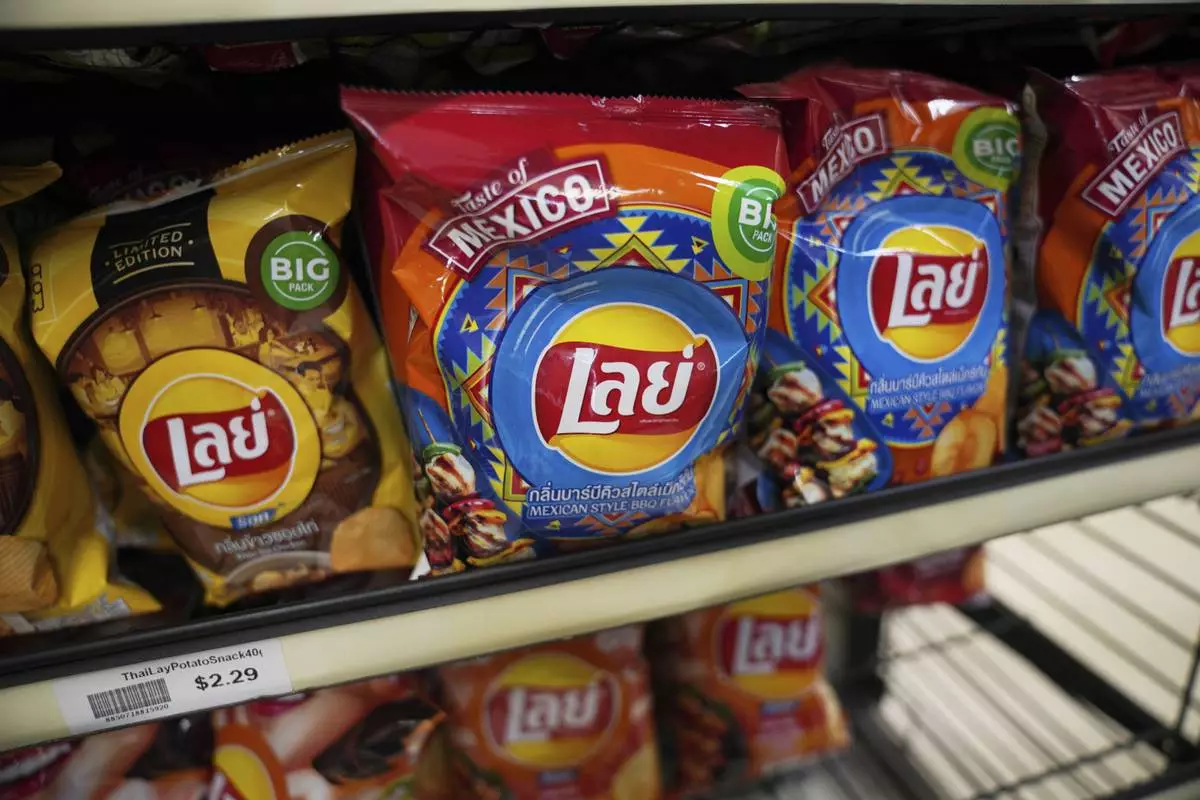RABAT, Morocco (AP) — A Moroccan economist known for his work defending human rights was detained after criticizing the government in remarks posted on social media during a visit by French President Emmanuel Macron to the North African kingdom.
Prosecutors apprehended Fouad Abdelmoumni in Casablanca on Wednesday and announced he was under investigation on suspicion of disseminating false information and accusing others of crimes on social media, Morocco’s state news agency reported. If charged and convicted, he could face up to five years in prison under cybercrime statutes.
“This arbitrary arrest is part of a series of harassments targeting Abdelmoumni, as a measure aimed at retaliating against his bold positions in expressing his opinions and defending human rights,” the Moroccan Association in Support of Political Prisoners said in a statement Wednesday. “This arrest represents a further escalation in the authorities’ policy of repression against human rights and political activists in the country.”
Abdelmoumni, a former political prisoner, is the group's coordinator.
While Macron toured Rabat with Moroccan leaders including King Mohammed VI, the activist alleged in a post that Morocco was attempting to “blackmail” France using methods including espionage and withholding cooperation on managing illegal immigration.
Abdelmoumni is yet to be officially arraigned. When he appears in court on Friday, he will likely be charged with crimes related to the post, one of his attorneys, Souad Brahma, said.
In Morocco, authorities can hold people under investigation for 48 hours without charging them.
Brahma said Abdelmoumni was arrested for expressing his opinion and called his detention a violation of his right to freedom of expression. She said she was denied a chance to visit him on Thursday despite receiving authorization from the court. Officials have not responded to allegations that the arrest was politically motivated.
Macron throughout his visit referred to opening a new chapter in relations between France and Morocco after years of strain.
The causes of friction included the 2021 “Pegasus Affair," in which Amnesty International and the Paris-based nonprofit group Forbidden Stories published a report alleging that Moroccan authorities had used the Israeli software Pegagus to infiltrate the electronic devices of human rights activists including Abdelmoumni and politicians all the way up to Macron.
Morocco strenuously denied the allegations and sued, claiming defamation.
Abdelmoumni, 66, has been prominent in defending human rights since he was imprisoned and tortured alongside other left-wing activists during King Hassan II's era of repression known as the “Years of Lead.” He has publicly supported pro-democracy efforts in the country, including during the Arab Spring and Morocco's 2017 “Hirak” movement.
After the investigation into Pegagus software, Abdelmoumni was among the activists profiled in a 2022 Human Rights Watch report on Morocco's targeting of critics.
The report said an anonymous person distributed a video of him and his then-partner-now-wife having sex, likely shot from a hidden camera inside his home's air conditioner. In Morocco, non-marital sex is a crime and information about their relationship later appeared in pro-government media as part of an effort that Abdelmoumni said was designed to intimidate him.
This week, he participated in a vigil demanding justice for a Moroccan nationalist who was “disappeared” in France in 1965, and appeared at courthouse where Morocco's ex-human rights minister was facing trial. He was going to a meeting of the Moroccan Association for the Support of Political Prisoners when he was apprehended.
Macron's political party helped push through a 2023 resolution in the European Union's Parliament condemning human rights abuses in Morocco. But the two countries have recently deepened political and economic ties. This week, they announced economic agreements and lucrative contracts on projects ranging from transportation to desalination infrastructure, and Macron reiterated his support for Moroccan sovereignty over the disputed Western Sahara.
During his three-day visit, Macron did not mention human rights in speeches at a business forum, to the country's French community or at the country's parliament.

French president Emmanuel Macron waves to Moroccans after delivering a speech in the Parliament, in the capital Rabat, Tuesday, Oct. 29, 2024 (AP Photo/Mosa'ab Elshamy)
WORTHINGTON, Minn. (AP) — Two Guatemalans wearing traditional embroidered skirts bought coconut boba teas on an October afternoon at the bustling downtown Asian market. In decades past, the building served as this rural town’s hardware store where farmers shopped for hammers, nuts and bolts.
Over the past generation, immigrants from Southeast Asia, East Africa and now predominantly Central America have transformed this once overwhelmingly white community on the vast prairie. Students of color constitute more than 80% of those enrolled in K-12, Spanish is most children’s first language, and soccer is far more popular than football.
“ Literally everything has changed,” said Chad Cummings, a city councilor and co-owner of the local radio stations — including a new 24/7 Spanish-language one.
Immigration is a core issue for voters this election, and some of the 2024 campaign’s most charged political vitriol has swirled around its effects on towns small and big across the country.
Like most lifelong residents in this politically red area, Cummings is proud of Worthington’s cosmopolitan flair, thriving economy and booming population. Thanks to migrants, most of whom come to work in the pork processing plant next to giant corn silos on its outskirts, the town has bucked the trend of rural communities nationwide that never recovered from the 1980s farm crisis.
But such rapid change has come with significant challenges and costs, as schools, churches and law enforcement have sought to respond to new needs despite language and cultural barriers. Old-timers and newcomers in Worthington are grappling with perhaps the most basic question — how to turn very separate groups into one functioning community.
“There are many ‘us’ in Worthington,” Cummings said. “How do we become a true blended community? Is it happening? It is, in some aspects. Is it fully happening? No. Will it ever? I don’t know.”
“Assimilation is going to take education,” he added. “The minority population, who is the majority; the Anglo population. … Until we can get that blend to come together, how does it work? How is it going to work?”
Near her family farm, Julie Robinson attends the same Baptist church founded by Scandinavian immigrants in the 1870s where her grandmother worshipped in Swedish.
Two decades ago, the Indian Lake congregation was getting so small that they prayed for the miracle of five new families, she said. What they got was some 60 refugee families from Myanmar and Thailand, who today pack the Sunday afternoon service in their Karen language that follows the English one, one third its size.
Southeast Asians were the first foreign migrants to diversify Worthington, and the town has grown about 10% each of the past three censuses, to about 14,000 residents, said city administrator Steve Robinson. In Nobles County, of which Worthington is the seat, Latinos nearly tripled from 2000 to 2020, to more than 7,200 of 22,300 residents.
Government offices have hired bilingual employees since the bulk of customer service is in Spanish, Robinson said. The city has beefed up its recreation infrastructure, but struggles to address an acute housing shortage, with the few rental units going for big-city prices.
The economic and cultural changes are etched into the landscape, from the stores and churches to the baseball diamonds turned soccer pitches, where the fierce prairie wind mixes fallen leaves and corn husks.
Latinos and other immigrants have long gone from border states like Texas and California to revitalize Midwest towns like Worthington. They’re attracted not only by jobs but the feeling they’re safer and more familiar with the leave-doors-unlocked, no-traffic-lights pace of life, said Omar Valerio-Jiménez, a University of Texas at San Antonio history professor.
“You can’t get any more American than this,” said Kelly Asche, a senior researcher at Minnesota’s Center for Rural Policy and Development. “It’s like the 1950s, but also not. … It doesn’t look like it used to be.”
Longtime residents’ longing for the glazed donuts from shuttered Lang’s Bakery matches only the Latino newcomers’ enthusiasm for the fresh bread that’s now baked in myriad varieties from walnut to jalapeño.
Over a post-liturgy lunch of pancake-like injera bread, Ethiopian Orthodox Church chairperson Abebe Abetew said their new worship space is where he and fellow East Africans “feel in our own home.”
“Everything we see and smell is like home,” he added. At a nearby table, women in white veils called netela said they’re glad their children make friends from other ethnic groups in school — but still prefer to socialize with other Ethiopian and Eritrean mothers.
Cristina Cabrera, who fled poverty in Central America three years ago, has similar preferences.
“Here I feel as if I were in my town in Guatemala, they’re my countrymen,” she said of downtown El Mexicano grocery’s clients. “We have all gone through the same.”
Like her, husband and wife Denis Miranda and Oralia Garril were pleasantly surprised by how easily they settled in Worthington — among fellow Guatemalans, many from the same Indigenous highland region, and other Latinos, where they have no need to learn fluent English because of the prevalence of Spanish.
“We didn’t think that there was going to be a community of people who are of our own kind,” Miranda said after playing in the Catholic church choir and before starting an evening work shift.
That’s no different from immigrants of Northern and Central European descent who came in the 19th century and also tended to work, play and worship alongside compatriots.
But today, many migrants aren’t sure they’ll stay in Worthington. Some are undocumented and their status is precarious.
That raises uneasy questions about Worthington’s social fabric and how to celebrate distinct cultures while overcoming ethnic self-segregation.
“We need to have conversations without being so incendiary,” Asche said. “It’s going to be slow and it’s going to be tough.”
At St. Mary’s Catholic Church, there are separate Spanish- and English-language Masses to honor different worship styles, said the Rev. Tim Biren, who grew up in the area and has been the pastor for a year.
He has continued outreach to Hispanic immigrants who are the majority of parishioners, while trying to bring back more “Anglo” families, for instance adding a polka band to the parish fall festival.
First Lutheran Church was founded by Swedish immigrants, including the maids to the Dayton family, who lived up the block and went on to start a department store empire that became Target. For eight years, the church hosted the Ethiopian Orthodox congregation in rooms behind the sanctuary.
Some members chafed at the loud drumming coming through the wall, but most stuck to “their Christian call to welcome,” said the Rev. Jeanette McCormick. Some Ethiopian children continue to attend the Lutheran afterschool program, and the congregation has joined several others in helping hundreds of newcomers with everything from meals to furniture to winter clothing.
“A lot of people come unprepared,” McCormick said in the church room where donated boots, snow pants and heavy jackets were neatly organized for pickup.
In Worthington High School’s restrooms, notices in English and Spanish refer students to counselors who can get them supplies ranging from shampoo to backpacks.
Newcomers’ basic needs exceed material provisions, however. The town has free programs to help with everything from swimming safety – after a drowning in the downtown lake – to completing job applications and school enrollment.
“Anything that involves systems and institutions,” said Sharon Johnson, the school district’s community education director.
A priority is driver’s ed, since many immigrants don’t know basic driving rules.
A Minnesota law touted by Gov. Tim Walz last year allows undocumented migrants to apply for state driver’s licenses. Getting them to do so has been a goal of the community education center, the Catholic church and the police.
Officers have been trying to build trust among migrants so that common mishaps, from driving offenses to failing to mow lawns to disciplining children, don’t snowball into major problems, said Police Chief Troy Appel, who grew up here and has been chief for 10 years.
“We want people to be comfortable approaching us,” Appel said. “It all comes down to awareness from both sides.”
More worrisome is the concern that traffickers are taking advantage of undocumented migrants, especially unaccompanied minors, Appel said.
Last year, the U.S. Labor Department found that a sanitation service company had employed 22 minors at the Worthington meatpacking plant in hazardous conditions. In 2006, when the plant was owned by a different conglomerate, federal immigration authorities made more than 200 arrests in a raid.
Over the past 10 years, nearly 800 unaccompanied migrant children were released to sponsors in Nobles County, according to federal data compiled by the Migration Policy Institute.
One is Emerson Lopez, who was 11 when he came from Guatemala with his teenage sister. Now a high school student, he was practicing soccer at the new fieldhouse on a recent afternoon.
“I’ve been getting used to things,” Lopez said in Spanish before switching to fluent English.
For all of Worthington’s growing pains, school is one place where almost everyone sees hope.
Before the pandemic, they were bursting at the seams with new students – as many as 1,500 people would crowd into the elementary school, said Superintendent John Landgaard.
Nevertheless, it took several bond referendums and acrimonious debates over who should shoulder the financial burden before needed upgrades were approved. More than $130 million has been spent on school projects since 2010, Landgaard said.
Of the roughly 3,300 in-person students, 500 are English learners. In 2024, 82% of them are students of color, compared to 29% in 1999, said Pat Morphew, the district’s accountant.
Many students struggle if they come to the United States as adolescents, and many parents have a hard time engaging because they’re working multiple jobs.
But some children adapt so well that they’re back in the school as teachers – like instructor TahSoGhay Collah. She teaches third-grade English learners at the 700-student intermediate school that was built after the referendum.
“I’m glad to be back in my hometown,” said Collah. She came to Worthington when she was 10 and remembers how difficult it was to learn English while continuing to speak her native Karen, which is the third-most spoken of 44 languages in the schools.
Suzy Brandner has taught in Worthington for 34 years. When she started, there would be one or two non-native English speakers in a classroom. Today her fifth graders think it’s no big deal to be sitting next to Angel, Jason, Kajaughney or Ximena.
“It’s just joyful to see them enjoy each other,” she said. “I think the word is acceptance.”
Hundreds of students and families packed the high school gym on a recent evening for the combined concert with the middle school choirs. Looking like a United Nations on the prairie, they sang Mexican and Czech folk songs as well as “America the Beautiful.”
“Our kids don’t see color, they see people,” Landgaard said.
From the benches, former football player and 2012 graduate Brandon Riemersma-Feit applauded one of his middle-schoolers. He’s thrilled that his five children get to experience so much diversity.
He also hopes that more parents of all ethnicities will engage in community activities.
“We can be as diverse as you want, but if you’re not involved, you’re not really included,” he said.
__
Associated Press religion coverage receives support through the AP’s collaboration with The Conversation US, with funding from Lilly Endowment Inc. The AP is solely responsible for this content.

The sun rises over Okabena Lake and the town of Worthington, Minn., on Tuesday, Oct. 22, 2024. (AP Photo/Jessie Wardarski)

A religious sign is carved into a tree in a neighborhood of Worthington, Minn., on Monday, Oct. 21, 2024. (AP Photo/Jessie Wardarski)

A girl from Guatemala plays in the sand on the shore of Okabena Lake in Worthington, Minn., on Sunday Oct. 20, 2024. (AP Photo/Jessie Wardarski)

Tyler Olson, a Worthington police officer who also serves as a school resource officer, leads a D.A.R.E. class at the 700-student intermediate school in Worthington, Minn., on Tuesday, Oct. 22, 2024. (AP Photo/Jessie Wardarski)

Suzy Brandner, right, who has taught in Worthington for 34 years, talks with a student walking down the hall at the intermediate school, which serves grades three through five, in Worthington, Minn., on Tuesday, Oct. 22, 2024. (AP Photo/Jessie Wardarski)

TahSoGhay Collah, right, teaches a third-grade English learners class at the 700-student intermediate school that serves grades 3 through 5, in Worthington, Minn., on Tuesday, Oct. 22, 2024. (AP Photo/Jessie Wardarski)

Mary Engidaw, center, and her daughter Harmony Hall, right, applaud during a Worthington High School choir concert in Worthington, Minn., on Monday, Oct. 21, 2024. (AP Photo/Jessie Wardarski)

High school students perform in a choir concert at Worthington High School, in Worthington, Minn., on Monday, Oct. 21, 2024. (AP Photo/Jessie Wardarski)

Middle school and high school students perform a choir concert at Worthington High School, in Worthington, Minn., on Monday, Oct. 21, 2024. (AP Photo/Jessie Wardarski)

Community members play a game of soccer in the JBS Fieldhouse in Worthington, Minn., on Monday, Oct. 21, 2024. (AP Photo/Jessie Wardarski)

Young congregants play catch after a Karen-language service at Indian Lake Baptist Church, in Worthington, Minn., on Sunday Oct. 20, 2024. (AP Photo/Jessie Wardarski)

Parishioners pray during a Karen-language service at Indian Lake Baptist Church, while celebrating 15 years of partnership with the 150-year-old congregation founded by Swedish immigrants, in Worthington, Minn., on Sunday Oct. 20, 2024. (AP Photo/Jessie Wardarski)

Randy Robinson tills a corn field in preparation for the winter, in Worthington, Minn., on Monday, Oct. 21, 2024. (AP Photo/Jessie Wardarski)

An ear of corn is left in the fields farmed by Julie and Randy Robinson in Worthington, Minn., on Monday Oct. 21, 2024. (AP Photo/Jessie Wardarski)

The home and farm of Julie and Randy Robinson, which has been in their family for 132 years, in Worthington, Minn., on Monday, Oct. 21, 2024. (AP Photo/Jessie Wardarski)

Randy Robinson tills a corn field in preparation for the winter, in Worthington, Minn., on Monday, Oct. 21, 2024. (AP Photo/Jessie Wardarski)

Julie Robinson opens her garage on property her family has owned for 132 years, in Worthington, Minn., on Monday, Oct. 21, 2024. (AP Photo/Jessie Wardarski)

Women stand outside of the Ethiopian Orthodox Tewahedo Church after service on Sunday, Oct. 20, 2024, in Worthington, Minn. (AP Photo/Jessie Wardarski)

Mintamir Endanew, left, and other women at the Ethiopian Orthodox Tewahedo Church enjoy a post-liturgy lunch of pancake-like injera bread on Sunday, Oct. 20, 2024, in Worthington, Minn. (AP Photo/Jessie Wardarski)

Members of the Ethiopian Orthodox Tewahedo Church carry food across the street on Sunday, Oct. 20, 2024, in Worthington, Minn. (AP Photo/Jessie Wardarski)

A classic car sits in front of Mick’s Repair in Worthington, Minn., on Tuesday, Oct. 22, 2024. (AP Photo/Jessie Wardarski)

An aerial of the JBS Pork plant in Worthington, Minn., on Tuesday, Oct. 22, 2024. (AP Photo/Jessie Wardarski)

Chad Cummings, a city councilor and co-owner of the local radio stations, walks through Top Asian Food and Deli in Worthington, Minn., on Saturday, Oct. 19, 2024. (AP Photo/Jessie Wardarski)

Cultural and religious items are sold at Top Asian Food and Deli in Worthington, Minn., on Saturday, Oct. 19, 2024. (AP Photo/Jessie Wardarski)

Cristina Cabrera, who fled poverty in Central America three years ago, helps a customer pick a piñata at El Mexicano, a local grocery in downtown Worthington, Minn., on Saturday, Oct. 19, 2024. (AP Photo/Jessie Wardarski)

Lays chips with Thai writing and Mexican-style flavors are displayed for sale at Top Asian Food and Deli in Worthington, Minn., on Saturday, Oct. 19, 2024. (AP Photo/Jessie Wardarski)

Steve Robinson, Worthington’s city administrator walks into the newly constructed JBS Fieldhouse on Monday, Oct. 21, 2024, in Worthington, Minn. (AP Photo/Jessie Wardarski)

Children walk past El Mexicano, a grocery store in Worthington, Minn., on Sunday Oct. 20, 2024. (AP Photo/Jessie Wardarski)






































